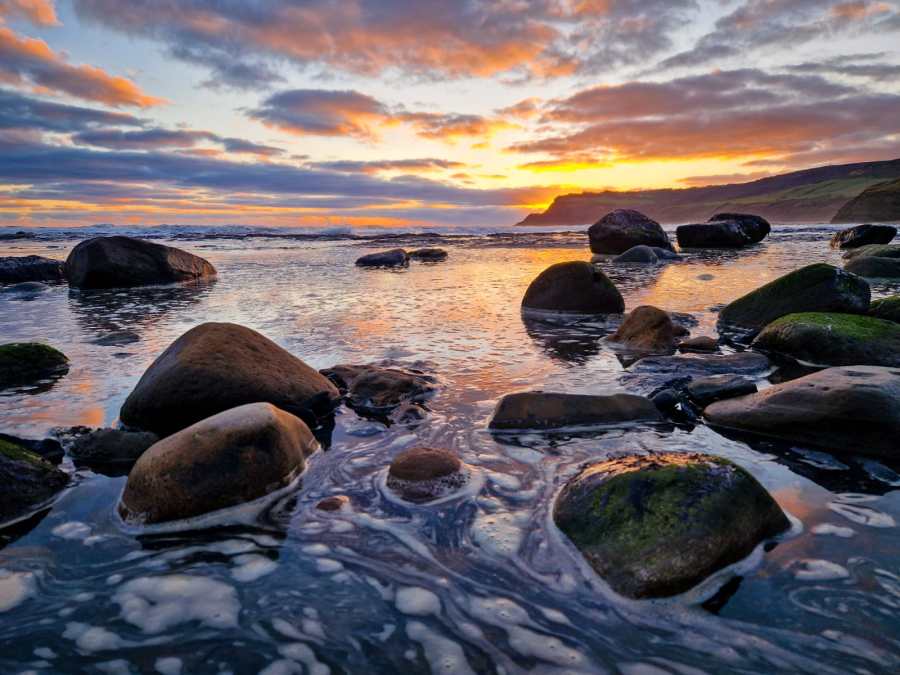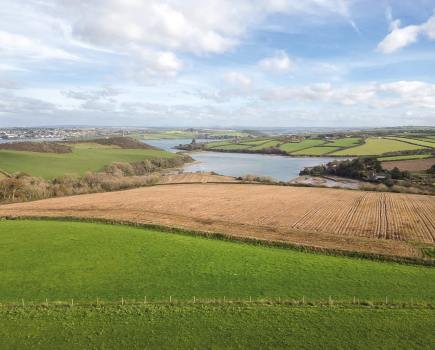The North Yorkshire coast’s ‘Jurassic age graveyard’ is a honeypot for rockhounds, unearthing prehistoric fossils and gemstones that have inspired myths and legends for millennia, discovers LUCY MCGUIRE.
We’re often told to ‘look up’ more in life, to pay closer attention to what’s happening around us. But, while walking the rock-strewn shores between Robin Hood’s Bay and the whimsically named Boggle Hole, you’ll feel compelled to look down.
Not because this mile-wide curve of beach, located between the jutting headlands of Ness Point and Ravenscar, doesn’t capture your attention. But, because the rock pools and flats of limestone and blue shale, or scaurs, found here and in neighbouring beaches, unearth some of Britain’s finest fossils and gemstones.
The journey to this section of North Yorkshire’s Heritage Coast (which spans around 50 miles between Saltburn and Filey), is spectacular. From behind the wheel, you rise and fall over Fylingdales Moor, being met with carpets of heather, vast skies and RAF Fylingdales’ sandcastle-like silhouette upon the horizon.
Having been raised some 30 miles inland, on the North York Moors National Park’s opposite edge, these North Sea-whipped shores — which you can admire from various vantage points across these moors — are my refuge, regularly pulling me back with the promise of fresh, salty air and a flick of the reset switch.
Explore Robin Hood’s Bay, affectionately known as ‘The Bay’ or ‘Baytown,’ and this frozen-in-time 17th-century village — with its maze-like alleyways, indie shops and curious seafaring and smuggling past — will instantly win your heart. Stay at the cosy Sunnyside Cottage, and you’ll be seconds from the beach and the village hubbub. Lovely sea views from its bedrooms are also guaranteed, with coral-coloured skies greeting you at sunrise. It is dog-friendly and was a recent winner in Theo Paphitis’ Small Business Sunday awards.
But what lures me here this time round is the desire to learn about the fossils and gemstones found along this so-called Dinosaur Coast. As Barrie Farnill wrote in A history of Robin Hood’s Bay, huge prehistoric ‘monsters’ and marine reptiles lived in this area some 220 million years ago, ranging from small crocodiles to the sharp-toothed plesiosaur.
And while it’s mostly keen-eyed fossil hunters who unearth these primeval creatures’ remains, this ‘Jurassic age graveyard’ is a playground for novice rockhounds, thanks to the abundant fossilised molluscs and famed Whitby Jet you’ll find here.
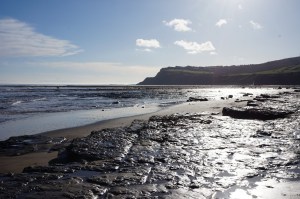
“[We are in] a unique geological location,” explains Byron Blessed, founder of fossil and gemstone shop, Natural Wonders, located in Whitby’s old town. “There’s a big focus on the Jurassic Coast in the south, but Whitby [and its environs] are equally important. It’s an untapped resource,” he says.
While fossils fill many shop windows across Whitby, Byron’s Aladdin’s Cave-like business is the most extensive. Before I’ve stepped beyond its canary yellow façade, my eye is caught by the gigantic ammonite displayed in the window. Inside, hundreds of pre-historic items — from a 100-million-year-old fossilised squid, found in Morocco’s Atlas Mountains; to shark and bear teeth and dazzling agates — all vie for my attention.
Our attraction to fossils, it turns out, has spanned centuries. Polished ammonites were worn as jewellery in Victorian Britain. And, during Medieval times, people believed ammonites were the snakes that Saxon Abbess Saint Hilda magically petrified before throwing them off Whitby’s cliffs, so she could found the town’s storied Abbey.
Today, in Whitby, the legend lives on via craftspeople who fix hand-carved snake heads onto these spiral-shaped cephalopods, selling them as souvenirs. And while rockhounds travel from all corners of the world to join Byron — a qualified geologist and palaeontologist — on his fossil-hunting tours, they come for the jewellery scene, too — in which fossils and Whitby jet have long played a part.
“There are eight miles of coastline where you can collect jet”, Imogen Redvers-Jones of Heritage Jet Jewellers tells me. “It’s quite a marmite gemstone because it’s black but you can get this incredible shine from it, which is why it was used for mirrors in the Bronze Age. Plus, it’s super light, so it’s fantastic for jewellery.”
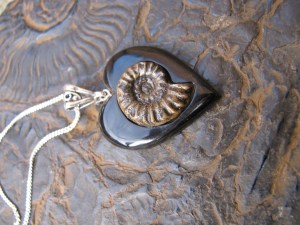
Like fossils, Jet was born out of the Jurassic period and while sometimes mistaken for coal, unlike the fossil fuel, it formed purely from fossilised wood, compressed over millions of years. It’s found in many countries, but experts believe Whitby’s hard, ‘yellow-skin’ jet is the best quality.
“If you pick up [what you think is] jet on the beach and it’s sparkly, it’s coal. Jet has no silica in it, so isn’t glittery like coal is,” explains Imogen. “It warms up to the touch quickly and produces a gingery, brown dust if you rub it with an emery board or sandpaper.”
Like the ammonite, jet is synonymous with legends and superstitious beliefs. In her book Jet Jewellery and Ornaments, Hellen Muller explains how, due to the mineraloid’s static electrical charge, early primitive man believed it had magical powers, wearing carved jet talismans as protection.
Fast forward some 5,000 years to Victorian Britain and Whitby’s Jet jewellery scene was established, thanks to the naval pensioner, Captain Tremlett, who had seen amber beads being produced in the Baltic, using a lathe. The demand for large, intricately carved pieces of this rich black lignite grew further after Queen Victoria decreed that Jet would become the British Empire’s official mourning stone.
“For many years, jet was mined inland where it appeared in seams of shale,” Imogen explains. “They also put people over the cliffside to chip out exposed seams.”
Equally perilous were the dust-filled workshops, of which 200 filled Whitby in the 1860s. Local jet carvers were nicknamed ‘The Whitby Red Devils,’ thanks to the cinnamon-hued dust that covered them while grinding, carving and polishing the stone using machinery that carried many risks.
10 great things to do along the Jurassic Coast
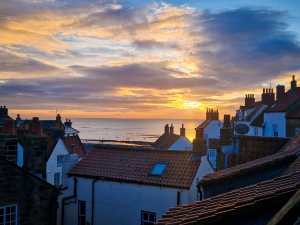
While the last of Whitby’s Victorian jet carvers died in the 1960s, Imogen’s business houses the last of these workshops, originally found in a cottage attic in Whitby’s Burns Yard and carefully moved here by her father and grandad in the 1990s (both skilled jet carvers), to be preserved as a museum.
After learning from her Master Carver dad, Hal Redvers-Jones, Imogen is now one of the few craftspeople to still carve and restore jet jewellery in the Victorian style, keeping Whitby’s heritage alive.
“It can be the most maddening material,” she says. “If it’s flawed, it can crack, but if it’s good Jet and the Jet Gods are on your side, it makes it all worth it.”
As I scour the beach at low tide, my daughter is delighted to find a belemnite. We don’t find Jet this time, but the dream to discover it one day is an excuse to return to these captivating shores.
For more information see discoveryorkshirecoast.co.uk, whitbyjet.co.uk and baytownholidaycottages.co.uk
How fossils helped Britain make its first geological map
The so-called ‘Father of English Geology,’ William ‘Strata’ Smith, created one of Britain’s very first geological maps, thanks to the fossils found in North Yorkshire. Leading to what The Yorkshire Museums Trust hailed ‘The map that changed the world,’ geologist William ‘Strata’ Smith studied the rocks around the country and dated the different layers, or strata, using the various fossil types he found embedded in Yorkshire’s coast. Smith went on to design the Scarborough Rotunda Museum — which displays a copy of the map today — and was credited with providing a detailed guide for Industrial Britain, having great implications for coal mining, agriculture and the building of canal networks.
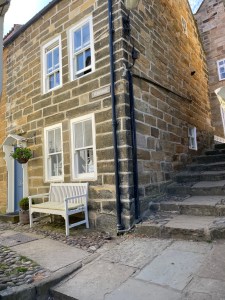
Sunnyside cottage is minutes from the beach and offers a cosy stay in Robin Hood’s Bay, known affectionately as ‘The Bay’
Tips for fossil & jet collecting
Respect the tides: Start your beachcombing three hours before low tide. Avoid going out between low and high tide.
Search in the rockpools: Some of the best fossils and sea-washed jet often get caught in the crevices of rockpools when the tide goes out.
Be responsible: Taking loose rocks from the beach is ok, but don’t dig into the cliff face and steer well clear of the cliffs. The risk of being hit by falling rocks is high in this region.
Stick to daylight hours: Never go fossil hunting in the dark, even if you plan on bringing a torch.
Protect yourself: Always wear good footwear and if you do chip into loose rocks, wear protective eyewear.

